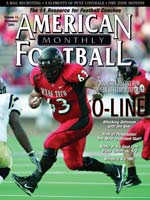AMERICAN FOOTBALL MONTHLY THE #1 RESOURCE FOR FOOTBALL COACHES
Article CategoriesAFM Magazine
|
4 Technical Components of Punt Coverageby: Granville Eastman© More from this issue At Austin Peay, we are a spread punt team. We like the spread punt because we believe it gives us big play capability in the coverage part of the punt as well as a chance to cover our punts more efficiently. To us, our punt is like a defensive play that occurs some 35-40 yards downfield. We like to directional kick so that we can put our ends (also referred to as ‘Gunners’) into play. Because every phase of our kicking game is installed and taught as a ‘Part to Whole’ concept, we break down our punt coverage into four basic components. Each component has an assignment and technique to be used with that position. 1. Penetrators/Ball men: Ends and Long Snapper With our ends we have ‘on the ball man’ or spill player and an ‘off the ball man’ or force player. The direction of the kick will dictate assign....The full article can only be seen by subscribers. Subscribe today!
|
|
|||||||
| HOME |
MAGAZINE |
SUBSCRIBE | ONLINE COLUMNISTS | COACHING VIDEOS |
Copyright 2025, AmericanFootballMonthly.com
All Rights Reserved





